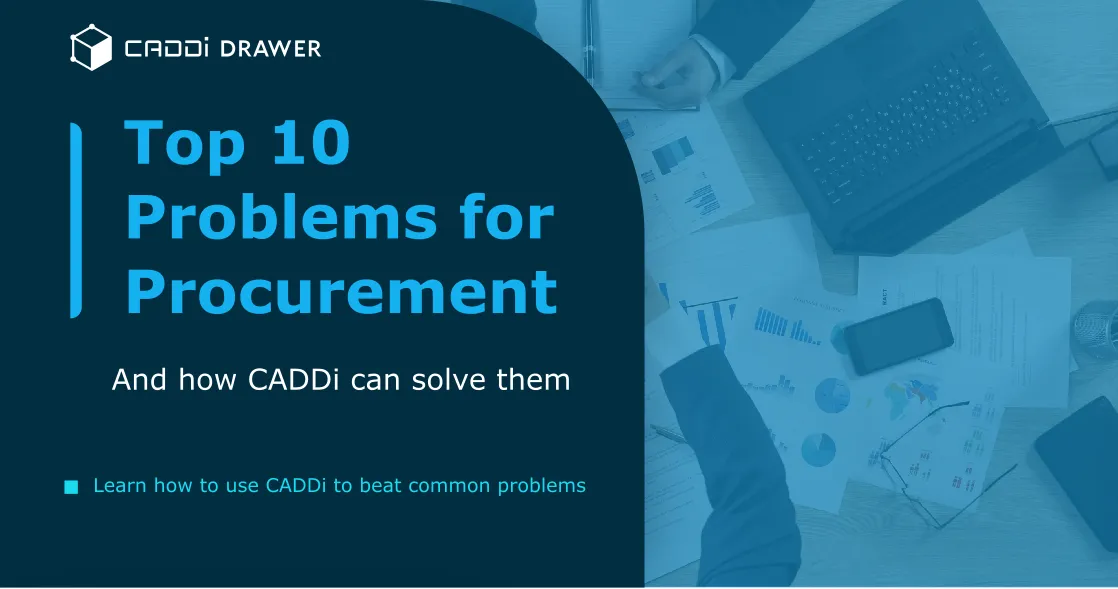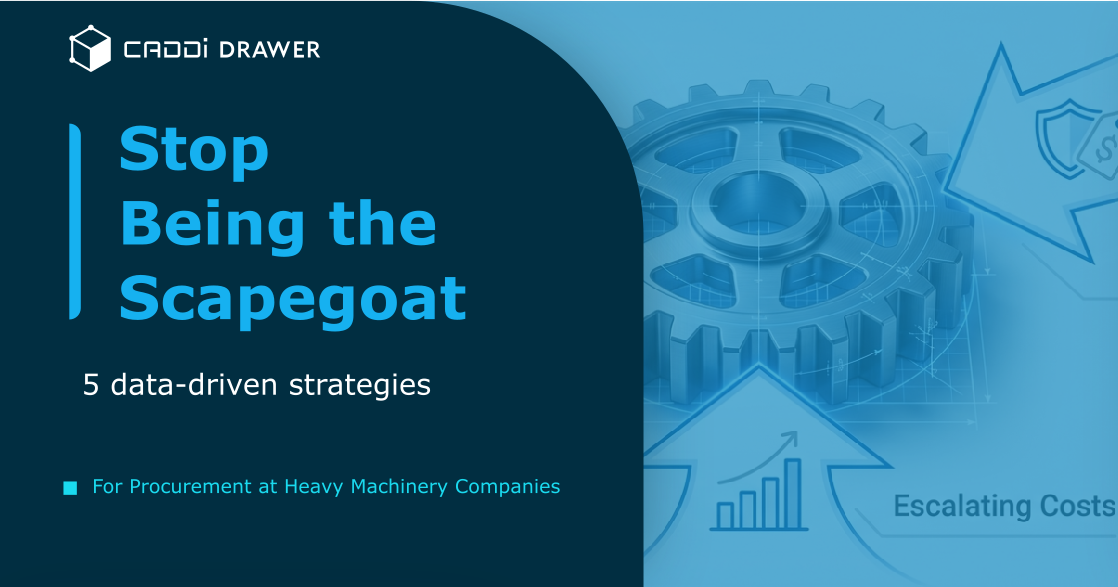Five Ways CADDi Helps you Avoid Costly Tariff Errors

Table of Contents

The modern trade environment is characterized by intense volatility, driven by the broad and rapidly changing application of tariffs. For American manufacturers, this geopolitical climate creates not just a cost shock through elevated production costs, but also a significant compliance risk that can result in massive financial penalties.
The critical challenge lies in the sheer complexity of classifying imported multi-material components according to the Harmonized Tariff Schedule of the United States (HTSUS) and calculating adherence to agreements like USMCA. This process demands granular component data, often residing in disorganized or unstructured formats. Failure to provide this level of detail constitutes a failure to exercise "reasonable care" required by U.S. Customs and Border Protection (CBP), which can trigger penalties reaching up to the full domestic value of the merchandise, or four times the duties lost, depending on the culpability level.
CADDi, as an AI data platform for manufacturing intelligence, provides the infrastructure needed to shift from reactive compliance to proactive, data-driven risk mitigation. Here are five specific ways CADDi helps manufacturers avoid the financial hazards and operational drag caused by tariff errors:
1. Automating Component Data Extraction for HTS Compliance
The most fundamental tariff error is a classification failure due to a systemic lack of granular Bill of Materials (BOM) data, particularly for composite goods that require detailed material breakdowns. This deficiency forces classification into high-duty, generalized headings, effectively penalizing data ambiguity.
CADDi addresses this by leveraging Optical Character Recognition (OCR) and machine learning to automate the ingestion of data from unstructured supplier documents, such as legacy paper drawings, scanned PDFs, and handwritten notes. This technology extracts critical component attributes—like material composition, dimensions, and manufacturing specifications—and converts them into structured, machine-encoded text. By automating this vital data collection, CADDi provides the verifiable, evidence-based foundation necessary to support HTS classification arguments and meet CBP’s standard of reasonable care, dramatically reducing the risk of hefty fines associated with negligence or misclassification.
2. Streamlining Regional Value Content (RVC) Audits
Preferential trade agreements, like the USMCA, require an even deeper level of traceability, demanding manufacturers maintain comprehensive cost analyses to validate Regional Value Content (RVC) calculations. Errors here can lead to the retroactive application of full tariffs spanning up to five years, alongside massive penalties.
CADDi helps prevent this financial disqualification by acting as a unified manufacturing data lake that links engineering data with supply chain records. The platform automatically links detailed drawing specifications, which serve as essential documentation, with associated data from ERP and PLM systems, including cost records, purchase orders (PO), and supplier information that confirms the origin of non-originating components. This capability allows manufacturers to generate comprehensive BOM Intelligence and RVC worksheets instantly, ensuring accounting records can rigorously trace component origin and cost for verification audits.
3. Mitigating Volatility with Predictive Price Sensing
Tariffs introduce profound uncertainty into cost forecasting, forcing input costs to become a moving target and causing pricing and quoting paralysis. If manufacturers over-quote to compensate for risk, they lose bids; if they under-quote, they lose profitability.
CADDi counters this volatility by enabling predictive price sensing and should-cost modeling. By finding historically similar parts using patented shape-based search technology, CADDi instantly surfaces all relevant contextual data, including historical order costs, supplier performance, and quality data. This allows procurement teams to identify pricing patterns between design features and costs at a glance, providing a data-backed baseline for what a part should cost even when market material prices or tariffs fluctuate. This empowers negotiation and ensures that new bids are both competitive and profitable, shielding margins from unexpected tariff hikes.
4. Accelerating the Pivot to Alternative, Non-Tariffed Suppliers
The immediate operational impact of new tariffs is often supply chain paralysis and a frantic scramble to re-source parts away from tariffed regions. This operational drag consumes time and resources, slowing product development and increasing costs.
CADDi enhances supply chain agility and flexibility, allowing manufacturers to quickly surface alternative, non-tariffed components. The system's similarity search is crucial here: when a critical imported component is hit by a tariff, the team can use its design drawing to instantly find functional equivalents that were previously sourced domestically or from a non-tariffed country. This ability to analyze design features across the entire parts catalog drastically reduces the time needed to identify and qualify new suppliers, making the strategic goal of supply chain diversification or reshoring operationally feasible and financially viable. CADDi enables teams to quickly surface alternate suppliers for any given part to navigate around tariffs and other sudden disruptions.
5. Enabling Strategic Tariff Engineering (Design Optimization)
Forward-thinking manufacturers practice Tariff Engineering, which involves legally modifying a product or manufacturing process to achieve a more favorable HTS classification or meet RVC requirements, thereby reducing duty liability. Without linked data, this complex analysis is prone to errors and major rework.
CADDi facilitates this strategic maneuver by embedding Value Analysis/Value Engineering (VAVE) principles directly into the design and procurement workflow. By linking costs directly to design drawings, CADDi allows engineers and procurement teams to analyze the cost impact of minute design features. This enables them to pinpoint materials (like copper or steel) subject to high tariffs, and strategically modify the design, adjust tolerances, or standardize components to either reduce the material's necessary volume or shift the product's classification away from a high-duty category. This proactive cost-effective choice is guided by data, ensuring compliance and maximizing savings.
In essence, CADDi transforms the tariff challenge from an impossible compliance burden into a solvable data problem. By industrializing the chaotic data extraction process and linking component drawings to financial realities, CADDi provides the clear visibility needed to avoid costly penalties, execute strategic supply chain pivots, and secure predictable profitability in a destabilized global market.
Ready to see how CADDi can help you get ahead in the tariff era? Explore our interactive product tour or book a personalized demo.
The modern trade environment is characterized by intense volatility, driven by the broad and rapidly changing application of tariffs. For American manufacturers, this geopolitical climate creates not just a cost shock through elevated production costs, but also a significant compliance risk that can result in massive financial penalties.
The critical challenge lies in the sheer complexity of classifying imported multi-material components according to the Harmonized Tariff Schedule of the United States (HTSUS) and calculating adherence to agreements like USMCA. This process demands granular component data, often residing in disorganized or unstructured formats. Failure to provide this level of detail constitutes a failure to exercise "reasonable care" required by U.S. Customs and Border Protection (CBP), which can trigger penalties reaching up to the full domestic value of the merchandise, or four times the duties lost, depending on the culpability level.
CADDi, as an AI data platform for manufacturing intelligence, provides the infrastructure needed to shift from reactive compliance to proactive, data-driven risk mitigation. Here are five specific ways CADDi helps manufacturers avoid the financial hazards and operational drag caused by tariff errors:
1. Automating Component Data Extraction for HTS Compliance
The most fundamental tariff error is a classification failure due to a systemic lack of granular Bill of Materials (BOM) data, particularly for composite goods that require detailed material breakdowns. This deficiency forces classification into high-duty, generalized headings, effectively penalizing data ambiguity.
CADDi addresses this by leveraging Optical Character Recognition (OCR) and machine learning to automate the ingestion of data from unstructured supplier documents, such as legacy paper drawings, scanned PDFs, and handwritten notes. This technology extracts critical component attributes—like material composition, dimensions, and manufacturing specifications—and converts them into structured, machine-encoded text. By automating this vital data collection, CADDi provides the verifiable, evidence-based foundation necessary to support HTS classification arguments and meet CBP’s standard of reasonable care, dramatically reducing the risk of hefty fines associated with negligence or misclassification.
2. Streamlining Regional Value Content (RVC) Audits
Preferential trade agreements, like the USMCA, require an even deeper level of traceability, demanding manufacturers maintain comprehensive cost analyses to validate Regional Value Content (RVC) calculations. Errors here can lead to the retroactive application of full tariffs spanning up to five years, alongside massive penalties.
CADDi helps prevent this financial disqualification by acting as a unified manufacturing data lake that links engineering data with supply chain records. The platform automatically links detailed drawing specifications, which serve as essential documentation, with associated data from ERP and PLM systems, including cost records, purchase orders (PO), and supplier information that confirms the origin of non-originating components. This capability allows manufacturers to generate comprehensive BOM Intelligence and RVC worksheets instantly, ensuring accounting records can rigorously trace component origin and cost for verification audits.
3. Mitigating Volatility with Predictive Price Sensing
Tariffs introduce profound uncertainty into cost forecasting, forcing input costs to become a moving target and causing pricing and quoting paralysis. If manufacturers over-quote to compensate for risk, they lose bids; if they under-quote, they lose profitability.
CADDi counters this volatility by enabling predictive price sensing and should-cost modeling. By finding historically similar parts using patented shape-based search technology, CADDi instantly surfaces all relevant contextual data, including historical order costs, supplier performance, and quality data. This allows procurement teams to identify pricing patterns between design features and costs at a glance, providing a data-backed baseline for what a part should cost even when market material prices or tariffs fluctuate. This empowers negotiation and ensures that new bids are both competitive and profitable, shielding margins from unexpected tariff hikes.
4. Accelerating the Pivot to Alternative, Non-Tariffed Suppliers
The immediate operational impact of new tariffs is often supply chain paralysis and a frantic scramble to re-source parts away from tariffed regions. This operational drag consumes time and resources, slowing product development and increasing costs.
CADDi enhances supply chain agility and flexibility, allowing manufacturers to quickly surface alternative, non-tariffed components. The system's similarity search is crucial here: when a critical imported component is hit by a tariff, the team can use its design drawing to instantly find functional equivalents that were previously sourced domestically or from a non-tariffed country. This ability to analyze design features across the entire parts catalog drastically reduces the time needed to identify and qualify new suppliers, making the strategic goal of supply chain diversification or reshoring operationally feasible and financially viable. CADDi enables teams to quickly surface alternate suppliers for any given part to navigate around tariffs and other sudden disruptions.
5. Enabling Strategic Tariff Engineering (Design Optimization)
Forward-thinking manufacturers practice Tariff Engineering, which involves legally modifying a product or manufacturing process to achieve a more favorable HTS classification or meet RVC requirements, thereby reducing duty liability. Without linked data, this complex analysis is prone to errors and major rework.
CADDi facilitates this strategic maneuver by embedding Value Analysis/Value Engineering (VAVE) principles directly into the design and procurement workflow. By linking costs directly to design drawings, CADDi allows engineers and procurement teams to analyze the cost impact of minute design features. This enables them to pinpoint materials (like copper or steel) subject to high tariffs, and strategically modify the design, adjust tolerances, or standardize components to either reduce the material's necessary volume or shift the product's classification away from a high-duty category. This proactive cost-effective choice is guided by data, ensuring compliance and maximizing savings.
In essence, CADDi transforms the tariff challenge from an impossible compliance burden into a solvable data problem. By industrializing the chaotic data extraction process and linking component drawings to financial realities, CADDi provides the clear visibility needed to avoid costly penalties, execute strategic supply chain pivots, and secure predictable profitability in a destabilized global market.
Ready to see how CADDi can help you get ahead in the tariff era? Explore our interactive product tour or book a personalized demo.
.svg)



.svg)
.svg)
.svg)









